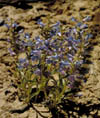
click picture for larger version
Common Name: Narrowleaf Penstemon
Other Common Names: Narrowleaf Beardtongue, Sand Beardtongue
Scientific Name: Penstemon angustifolius
Family: Figwort Family (Scrophulariaceae)
Distribution: southern Intermountain region
Habitat: desert shrub and juniper communities, on sandy soils
Habit: perennial herb
Height: 0.5-1.5'
Spread: 1'
Foliage Color: waxy, gray-green
Leaves: linear or lance-shaped, leathery, not toothed, to 4" long, opposite, mostly along the stem, not basal
Flower Color: pink, lavender, or baby blue, depending on geographic variety, with a golden "beardtongue" (sterile fifth stamen)
Flower Form: flowers snapdragonlike, borne in terminal spikes
Cultural Requirements: Prefers full sun and coarse, well-drained soils. Fully cold-hardy. Drought hardy (i.e., needs no supplemental water after establishment on the Wasatch Front) and intolerant of overwatering and excessive fertility.
Culture: Narrowleaf penstemon seeds are dormant at maturity, require 8-12 weeks of moist chilling to become germinable, and germinate in chilling. The germinated seeds should be planted in elongate containers, as penstemon roots like to grow down at first, not out. Plants require two years to flower. This species may be direct-seeded in late fall for spring emergence, but is not tolerant of competition and generally thrives best in sandy soils.
Uses and Notes of Interest: Narrowleaf penstemon is made up of a series of geographic races or varieties. In the Uinta Basin, var. vernalensis with its baby- blue flowers and narrow leaves will be encountered. On the sand dunes of the West Desert, var. dulcis, a similar plant but with pink flowers, is found. Down in Capitol Reef country, a lavender-flowered form with broader leaves, var. venosus, is the plant you will see. All are very pretty, with compact forms that feature a high flower-to-leaf ratio, rather narrow flowers up to an inch in length, and few or no basal leaves at flowering time. The seeds we are planting today are from variety dulcis. Penstemon seeds are borne in dry, upright capsules and are easily collected by shaking into a paper bag, about a month to six weeks after flowering. Some years insects destroy most of the seeds.